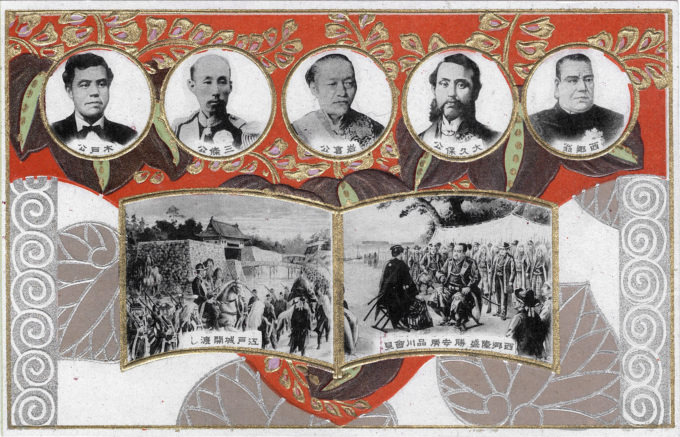
“Five Important Persons of the New Government”, commemorative postcard, c. 1910. Left-right: Kido Takayoshi aka Kido Koin (Councillor), Sanjō Sanetomi (Minister of the Right), Iwakura Shisetsudan (Great Councillor), Ōkubo Toshimichi (Councillor), Saigo Takamori (Councillor). It was this coalition of anti-Bakufu han leaders who toppled the Tokugawa shogunate and restored imperial rule in 1868. Right inset: Katsu Kaishu surrendering Edo Castle to Saigo Takamori (11 April 1868). Left inset: The arrival of Emperor Meiji on horseback at Edo Castle (26 Nov 1868).
See also:
Exposition celebrating the 70th anniversary of the “Meiji Assembly”, Ueno Park, Tokyo, 1938.
“Emperor of Japan”, c. 1905.
“Upon the death of [Shogun Tokugawa] Iemochi his adviser and tutor Keiki became the fifteenth and last Shogun. Less than a month later Emperor Kōmei passed away and his fifteen-year-old heir ascended the throne to begin his long period of eventful rule which lasted for forty-five years. Having suffered irretrievable loss of power and prestige, the Bakufu was no longer in a position to manage effectively the affairs of state.
“Convinced that the time was now ripe, Iwakura worked secretly with Saigō, Ōkubo, Kido, Sanjō, and others to plan the overthrow of the Shogunate. Opinion among the daimyō [provincial lords] was still divided as some advocated overthrow while others were loyal to the Bakufu … The astute Shogun had been watching the irresistible trend of events and had realized the impossibility of saving the Bakufu in the face of pressures from both within and without. As a matter of fact, he had already, at the time of his appointment as Shogun, made up his mind to surrender his powers at an opportune time.
“The opportunity came in the fall of 1867, and the Shogun announced his decision to relinquish his powers. Although the unexpected announcement took the country by surprise, no one questioned the wisdom of the decision. The Emperor forthwith accepted the Shogun’s petition requesting permission to surrender the political powers to the Throne. Thus, 265 years of Tokugawa rule came to an end, and with it almost seven centuries of feudalism passed out of existence.
“… Early in January of 1868, the Emperor issued the Restoration Rescript. Immediately, all the offices which had functioned under the feudal regime were abolished and a provisional machinery was set up with those who had actively participated in the Restoration in charge. This small group included Saigō, Ōkubo, Gotō, the court nobles, daimyō, and a few princes of the blood, but the real Power was in the hands of one man, Iwakura, a court noble.”
– Japan Since Perry, Chitoshi Yanaga, 1949

